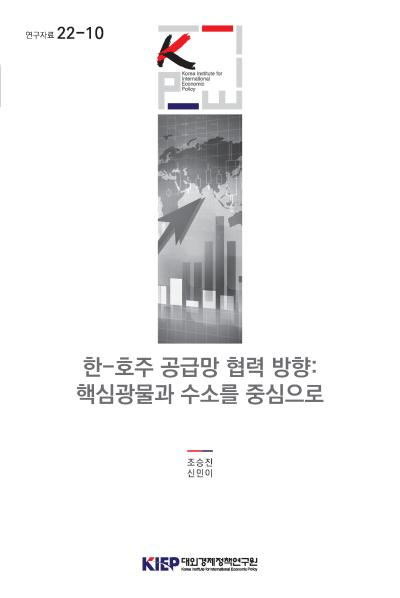Policy Reference
Publications
Policy Reference
To list

Korea-Australia Supply Chain Cooperation: Focus on Critical Minerals and Hydrogen
economic security, economic cooperation
Author Seung Jin Cho and Minlee Shin Series 22-10 Language Korean Date 2022.12.30
The U.S.-China rivalry and COVID-19 have increased the supply chain's vulnerability and reshaped the global value chain. The weaponization of resources, such as Russia's natural gas export restrictions in response to the war in Ukraine, demonstrates that the government must take urgent measures to stabilize the supply chain. Korea relies entirely on critical minerals such as lithium, cobalt, nickel, and rare earths from other countries because these minerals are essential for the electric vehicle and secondary battery industry. Moreover, Korea will increasingly rely on hydrogen imports to achieve carbon neutrality by 2050.
Korea and Australia signed a memorandum of understanding on December 2021 for cooperation in the area of critical mineral supply chains, carbon-neutral technology and a clean hydrogen economy. Australia is the world's largest producer of lithium and contains large deposits of other critical minerals such as nickel, of which it has the largest reserves in the world. Australia has a favorable geographical environment for producing hydrogen. Australia also has the advantage of being relatively close to Korea, and is one of the countries expected to become a major hydrogen-exporting country. From Australia’s point of view, Korea offers a stable demand for critical minerals and hydrogen. Therefore, bilateral cooperation to stabilize the supply chain is expected to increase. Accordingly, this study analyzes Australia’s policy on critical minerals and hydrogen, and the current status of international cooperation. Based on this, effective measures to strengthen the supply chain cooperation between Korea and Australia are derived.
The Australian government announced its critical minerals strategy in 2019 and 2022. This critical minerals strategy and modern manufacturing initiative were launched to boost the weak indigenous manufacturing sector. The Australian government is also aiming to boost the capacity of downstream industries by leveraging its strengths in the mining sector of critical minerals. This policy is also found in Western Australia’s Future Battery Industry Strategy and Critical Minerals and High-tech Metal Strategy announced by the state government.
In addition, the Australian Government has announced the National Hydrogen Strategy in 2019 under the vision of becoming a leading country in the global hydrogen industry by 2030. Also, all Australian states are implementing a hydrogen strategy or plan, and are committed to fostering the green hydrogen sector. They also aim to promote demonstration projects and research assistance to improve efficiency in the hydrogen field, enhance community trust, and improve institutional problems.
Regarding Australia’s international cooperation in critical minerals, Australia participates in the multilateral Minerals Security Partnership. Australia and the U.S. plan to build a critical mineral facility in Texas to import critical minerals from Western Australia. Japan has been collaborating closely with Australia since China banned rare earth elements exports in 2010. Australia and Japan signed a critical minerals partnership in October 2022. The Australian state government and companies are also participating in the European Commodity Alliance launched in September 2020. Australia has also developed active research collaborations with India.
Australia's international cooperation in the field of hydrogen is focused on producing hydrogen in Australia, especially green hydrogen, and transporting it to partner countries for their own use. Japan can be evaluated as the country with the most progress in cooperation with Australia in the hydrogen field, and cooperation with Korea and Germany is also active. Many pilot projects, feasibility studies, and joint research projects are underway with Japan. Furthermore, exports between Australia and Japan for commercial purpose are expected to begin around 2025.
This study recommends four measures to secure the critical minerals supply chain. First, installing a critical minerals control tower will play a significant role in establishing Korea's long-term strategy for critical minerals and reducing investment risks for the private sector. Second, stronger linkage with the Australian industrial development strategy would help develop the secondary industry and Korean companies enter the Australian energy storage system market. Third, developing critical mineral technology through the establishment of a joint fund could improve critical mineral extraction productivity and strengthen competitiveness in the critical mineral processing field, where both Korea and Australia are weak. And the fourth measure is to establish a mini-lateral network that allows Australia, Korea, Indonesia or India to participate. This network would help construct a value chain between the participating countries.
This study proposes three methods to stabilize the hydrogen supply chain. First, Korea and Australia should conduct more demonstration projects to evaluate the commercial and technical feasibility of hydrogen cooperation projects, as the formation of the hydrogen supply chain is at an early stage. Second, technical development of hydrogen transportation is required to introduce hydrogen produced in Australia to Korea. This development will facilitate the hydrogen transportation sector and establish the entire hydrogen industry cycle. Third, policy efforts are required to preoccupy global hydrogen technology standards and reflect Korea’s opinions in international standardization organizations through cooperation with Australia.
Sales Info
| Quantity/Size | 93 |
|---|---|
| Sale Price | 5 $ |
 공공저작물 자유이용허락 표시기준 (공공누리, KOGL) 제4유형
공공저작물 자유이용허락 표시기준 (공공누리, KOGL) 제4유형
대외경제정책연구원의 본 공공저작물은 "공공누리 제4유형 : 출처표시 + 상업적 금지 + 변경금지” 조건에 따라 이용할 수 있습니다. 저작권정책 참조
